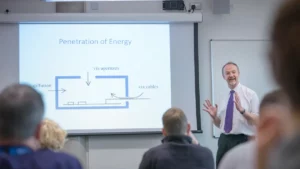
Following the first day’s discussion on the current needs of companies – how work “works” today – Maven’s panel of experts looked to current solutions in the marketplace aimed at meeting these needs.
The first day’s discussion highlighted various aspects of talent management and communication, and accordingly, much discussion of the second day included related solutions. Karen Swim noted that while collaborative communication platforms (like Google Applications, Slack, Skype, among many others) help facilitate speed while platforms like Real Presence Video conferencing “allows the nuances of in-person communication and provides a mechanism for real-time content sharing.” In connection with collaboration and team engagement, Tim Cowan and Gary Melling both noted the need to reimagine how performance assessments can help both the company and employee improve their skills and role suitability.
Suzanne White noted one way she has seen performance reviews function to support the culture and operations of the business, teams, and individuals: “Our annual reviews were based on 1) contribution to the company 2) contribution to self, and 3) contribution to colleagues – equally balanced and not in any order. So, our performance bonuses and compensation increases were 1/3 based on what we did to help others. This was the best culture I have worked in because it caused people to think equally about others as they did themselves and how they were contributing to the bottom line … Until we can change the reward system from “I” based to “us” based, this is going to continue to kill our businesses.”
The panelists also discussed what might happen to workers displaced by automation, for instance, in the agriculture industry where machines are supplanting or overtaking seasonal labor, or in transportation with autonomous vehicles. Paul Terlemezian suggests that “maybe the truck driver could do more interesting things besides driving. Perhaps the back of the truck could contain 3D printers that were producing pharmaceutical product or spare parts on the way to a disaster relief area. We could get the needed supplies there faster because the truck could drive while the “driver” was sleeping and the product was being manufactured in transit.”
Read the full discussion here, and follow along with us live. If you have any questions to ask the panel, tweet @MavenRes with the hashtag #AskAMaven. Thanks for tuning in!
Related Post
Categories
Recent Articles

Unlock Workforce Potential with Open Talent Networks | Boost Efficiency & Innovation

Has the world of consulting changed forever?

Internal talent marketplace

Experts on demand

The Art of Cultivating Wisdom: Unveiling the Power of Expert Advisor Networks

